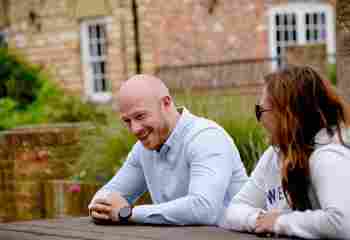More About Rehabs for Professionals
What Is an Impaired Professional Addiction Treatment Program?
An impaired professional treatment program is a type of substance use disorder (SUD) program created specifically for licensed professionals.
These programs are tailored for people in fields such as:
- Doctors.
- Lawyers.
- Pilots.
- Pharmacists.
- Nurses.
- Dentists.
- Physician assistants.
- Mental health care professionals.
Professionals may choose these programs because of the unique pressures tied to their work.
For example, some may experience vicarious trauma, developing symptoms similar to post-traumatic stress disorder (PTSD) after caring for patients with PTSD.(1) Others may struggle with compassion fatigue, which happens when constant exposure to distress reduces their ability to feel empathy.
Work-life imbalance, burnout, and the responsibility of caring for others can make professionals especially vulnerable to substance use.(2) When addiction develops, it can affect their health, their careers, and the safety of those they serve.(3)
Licensed professional programs help patients address these stressors while building a path to long-term recovery.
What Happens During Professional Addiction Treatment Programs?
Like other rehab programs, licensed professional programs are comprehensive and tailored to each patient.
The level of care depends on a person’s needs and can include:(4,5)
- Medical detox: Often the first step for patients with physical dependence. Under medical supervision, detox clears substances from the body while managing withdrawal symptoms. Medications may be used in tapering doses to reduce discomfort and help the body adjust. Detox prepares patients to begin recovery.
- Inpatient treatment: Patients live at the facility full-time and receive round-the-clock care. This option is best for those with severe SUD, co-occurring mental health concerns, or significant medical needs.
- Intensive outpatient programs (IOPs): Patients live at home and attend treatment several times a week, often with evening or weekend options. IOPs are designed for people with moderate SUD and a stable, supportive home environment.
- Outpatient programs: Patients attend counseling sessions or therapy a few hours per week. Outpatient care works well for those with mild SUD or those stepping down from a higher level of care and focusing on relapse prevention.
Treatment Approaches in Professional Rehab Programs
There are various types of therapy used in addiction treatment that may be used in all treatment programs, not just for those tailored to credentialed professionals.
These therapies include:(6,7,8,9)
- Cognitive-behavioral therapy (CBT): CBT works from the idea that thoughts, emotions, and behaviors all influence each other. Therapy focuses on changing unhelpful thought patterns and learning coping skills such that a person can experience more positive emotions and engage in healthier behaviors. One possible negative thought pattern among licensed professionals could be that they are not “supposed” to have the problems that they treat in others. CBT can help them see that no profession is immune to psychiatric conditions and that their personal experience can even help them to have compassion and empathy for those they serve.
- Motivational interviewing (MI): Those dealing with addiction often have inner conflicts about their use–while they want to stop using, there are also some benefits they gain from it. Motivational interviewing helps people weigh the costs versus benefits of substance use to help them get closer to readiness for change. Returning to work can be a significant motivator for credentialed professionals because of the time, education, and work that went into earning their licenses.
- Dialectical behavior therapy (DBT): DBT is a structured form of therapy that includes training in skills like mindfulness, interpersonal communication, and distress tolerance.) This therapy strategy is a fit for those with an SUD and co-occurring severe mental health conditions.) Strengthening these skills is important for those in professions that require mental focus.
- Contingency management (CM): CM is a commonly used strategy in SUD treatment and involves giving financial rewards for attaining goals like reducing use or maintaining abstinence. Research has found CM to be particularly effective in treating SUDs, which can help credentialed professionals maintain abstinence and return to work.
- Eye movement desensitization and reprocessing (EMDR): EMDR therapy is a treatment protocol used to treat PTSD that involves brain stimulation to reprocess traumatic memories such that they don’t continue to cause distress. One study has found that EMDR can be successful in reducing symptoms associated with vicarious trauma in a group setting.
Different therapy strategies can be used in the context of individual or group therapy. Often, in a rehab program, a person participates in both modalities.(4,5)
Individual therapy involves meeting one-on-one with a therapist. In this environment, a person can discuss something they are not comfortable addressing in a group setting. The environment is also conducive to silent time for the person to reflect on their experiences more deeply, gain insight, and release emotion.(4,5)
Group therapy, on the other hand, involves multiple people sitting in a circle with one or two therapists facilitating the discussion between group members. It provides a sense of universality and peer support and can be especially conducive to improving interpersonal communication.(10)
Furthermore, licensed professionals like physicians can, understandably, worry about stigma and treatment’s implications on their careers. Group therapy can be a place where professionals can share ideas on how to navigate re-entry into the workplace.(10)
What Happens After Completing a Professional Addiction Treatment Program?
Once licensed professional addiction treatment is completed, continued participation in aftercare programs, also known as follow-up care or continuing care, is important to maintain the progress made in treatment and help reduce the risk for relapse.(5)
Most programs recommend participating in aftercare for at least 1 year after rehab completion.(5) A person’s care team recommends the types of aftercare that may be best suited for them.
One example of an aftercare program is called sober living. This can help someone transition from rehab to independent living because it involves staying at an alcohol and drug-free environment.(5)
Sober living also includes counseling that is provided on-site.5 Another example of aftercare is participating in a 12-step group like Alcoholics Anonymous (AA) or Narcotics Anonymous (NA).
These are peer-led groups, not led by licensed therapists, where those dealing with SUDs come together to support each other.(11) Such peer support participation has been shown to increase chances of long-term abstinence.(11)
Yet another example of aftercare is individual counseling in which the therapist can help the person prevent relapse by continuing to learn and practice coping skills.(4) Therapists also often encourage participation in a 12-Step group at the same time.(4)
Does Health Insurance Cover Professional Addiction Treatment Programs?
Yes, using health insurance to pay for rehab is possible. Your insurance company can tell you what types of programs are covered by your plan and which specific licensed professional rehab facilities are in-network versus out-of-network.
Finding a Professional Rehab Program Near You
It’s never too late to seek help, and licensed professional rehab programs can help you get on the path to recovery. You can use our treatment directory to locate a rehab center by entering a keyword or location.
Sources
- Jimenez, R.R., Andersen, S., Song, H. & Townsend, C. (2021). Vicarious trauma in mental health care providers. Journal of Interprofessional Education & Practice, 24.
- Sinclair, S., Raffin-Bouchal, S., Venturato, L., Mijovic-Kondejewski, J. & Smith-MacDonald, L. (2017). Compassion fatigue: A meta-narrative review of the healthcare literature. International Journal of Nursing Studies, 69, 9-24.
- Story, J. & Solberg, D. (2017). Barriers to mental illness and substance abuse treatment among physicians and the impact on patient care. Missouri Medicine, 114(2), 91-93.
- National Institutes of Health. (2018). Principles of drug addiction treatment: A research-based guide (third edition).
- Substance Abuse and Mental Health Services Administration. (2014). What is substance abuse treatment? A booklet for families.
- Substance Abuse and Mental Health Services Administration. (2019). TIP 35: Enhancing motivation for change in substance use disorder treatment.
- Linehan, M.M. & Wilks, C.R. (2018). The course and evolution of dialectical behavior therapy. American Journal of Psychotherapy, 69(2), 97-110.
- Tsouvelas, G., Chondrokouki, M., Nikolaidis, G. & Shapiro, E. (2019). A vicarious trauma preventive approach. The Group Traumatic Episode Protocol EMDR and workplace affect in professionals who work with child abuse and neglect. Dialogues in Clinical Neuroscience & Mental Health, 2(3), 130-138.
- Substance Abuse and Mental Health Services Administration. (n.d.). Substance abuse treatment: Group therapy, TIP 41.
- Srivastava, A.B. (2018). Impaired physicians: Obliterating the stigma. The American Journal of Psychiatry Residents’ Journal, 13(3).
- Donovan, D.M., Ingalsbe, M.H., Benbow, J., & Daley, D.C. (2013). 12-step interventions and mutual support programs for substance use disorders: An overview. Social Work in Public Health, 28(0), 313-332.











































